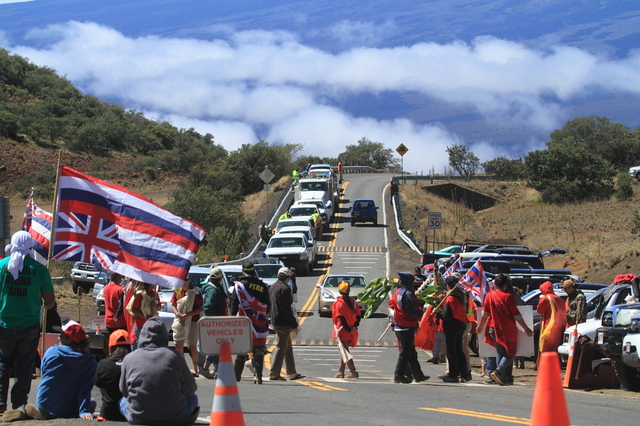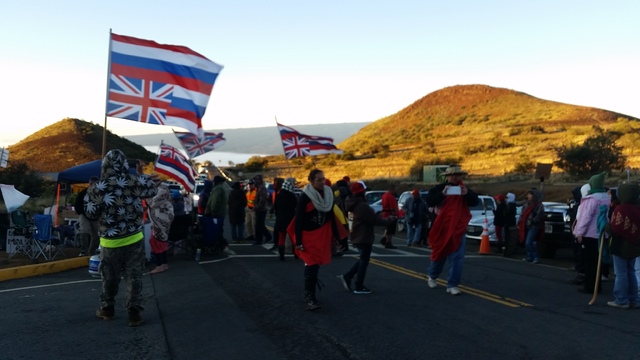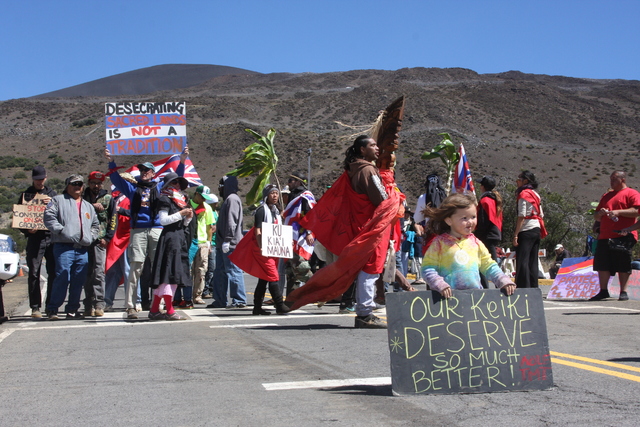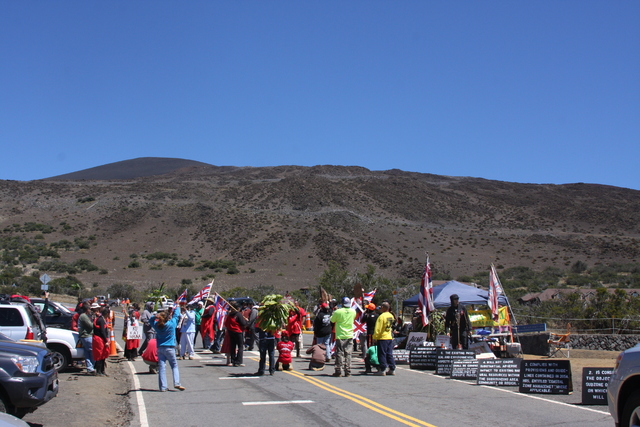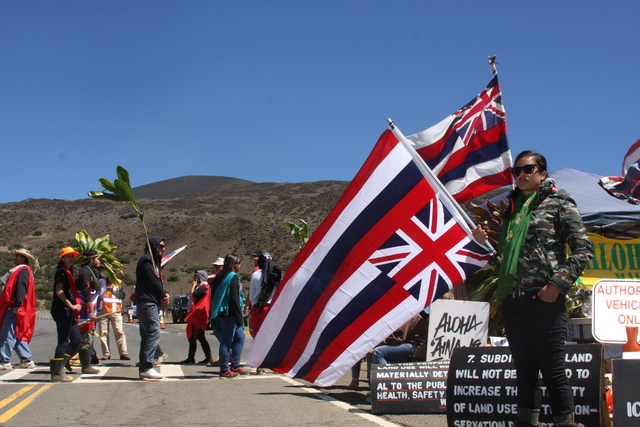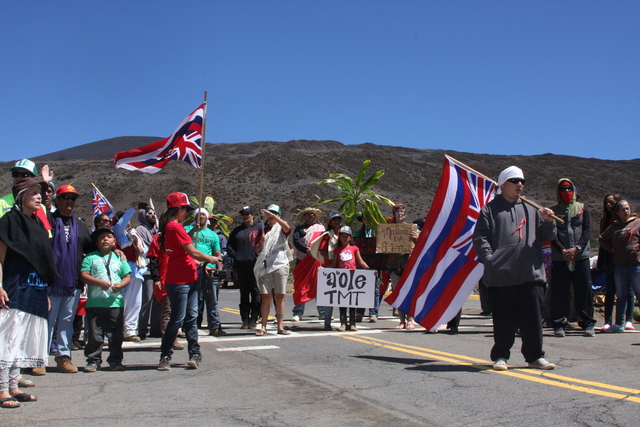Construction of the Thirty Meter Telescope ground to a halt Monday as more than 50 protesters formed a roadblock outside the Mauna Kea visitor center.
Calling the $1.4 billion project a desecration of the mountain, the activists marched back and forth across the Mauna Kea Access Road, making sure to stay within the crosswalk.
About 15 vehicles transporting workers up the mountain were blocked as a result, though the protesters allowed visitors and other telescope operators through.
The mood at the protest was upbeat, with contemporary and traditional Hawaiian songs filling the mountain air. More than a dozen police officers looked on but took no action against the demonstration.
Protesters, who were mostly Native Hawaiian, said their message was about aloha and not anger toward the workers.
“Our stance is not against the science,” said Lanakila Mangauil, 27, of Honokaa. “It’s not against the science. It’s not against the TMT itself. It’s against their choice of place.”
The TMT, scheduled to achieve first light in 2024, will be the 13th observatory on the mountain and one of three next-generation telescopes under development. Two others will be built in Chile.
Astronomers say the telescope will allow them to peer closer to the start of the universe and answer more of its great mysteries.
TMT is expected to create 300 full-time construction jobs and 120 to 140 permanent jobs, but protesters said there already has been too much development on Mauna Kea.
Ruth Aloua, 26, of Kailua-Kona, said they were standing up for their ancestors and the mountain’s sacred status.
“We have an ancestral, a genealogical relationship to this place,” she said. “And that is what we are protecting. We are protecting our kupuna through aloha aina.”
TMT Project Manager Gary Sanders said workers waited for more than eight hours at the roadblock before heading back down the mountain.
“TMT, its contractors and their union employees have been denied access to our project site by a blockaded road,” he said in a statement. “Our access via a public road has been blocked by protesters, and we have patiently waited for law enforcement to allow our workers the access to which they are entitled.”
He said state officials approved the project after a “lengthy seven-year public process.”
The protesters said some of them have kept a nearly 24-hour presence outside the visitor center, located at about 9,200 feet, since Wednesday following the arrival of construction equipment the day before.
Wallace Ishibashi, the project’s construction monitor, estimated about two days worth of work occurred last week at the site located at the 13,150-foot elevation. That work is currently focused on site clearing and preparing the location for the observatory.
Protesters also disrupted a groundbreaking ceremony at that site last October.
Ishibashi, who also sits on the Hawaiian Home Lands Commission, noted the project has all of the permits and approvals it needs from the state. He said he didn’t see spirituality and science as being in conflict on the mountain.
“I love the science,” he said. “It’s the sacred science of astronomy here on the mountain. … We aren’t human beings having a spiritual experience; we’re spiritual beings having a human experience. So this is just part of our journey of returning back home to Akua.”
TMT won a legal challenge of its conservation district use permit, initially granted after a contested case hearing, last year. Appeals of that decision and the granting of a sublease remain pending, according to the plaintiffs.
A construction worker, who declined to give his name, said they were about four weeks away from moving earth at the site. He estimated it would take another year to begin to build the large structure.
Building permits for the observatory are expected to be filed this summer, said Neil Erickson, Hawaii County building division plans examining manager. He also didn’t expect to see any major construction begin until next year.
Since the state Department of Land and Natural Resources approved a sublease for the project last June, the TMT International Observatory has made $300,000 in lease payments, said Dan Meisenzahl, a University of Hawaii spokesman. UH operates the Mauna Kea Science Reserve.
Eighty percent of those funds goes to the Office of Mauna Kea Management’s land management special fund, he said. The other 20 percent goes to the Office of Hawaiian Affairs.
The lease payments will increase gradually until they reach $1.08 million after 11 years.
TMT also is donating $1 million a year to benefit science, math and technology education on Hawaii Island.
Protesters said the jobs and funding don’t justify the project.
“It’s not about the instant paycheck,” said Mangauil. “We are looking further; we are looking farther than that. We need to get ourselves out of those shackles in which we are forced to do what we know in our heart is not pono and what is not good for our environment.”
Protesters said part of their mission was to educate visitors, who mostly looked on with curiosity, about the mountain’s sacredness and cultural importance.
“I’m just enjoying their singing,” said Johanne Brideau of Sweden. “They sing very upbeat.”
A mixture of state conservation officers and Hawaii County police watched the protesters.
Capt. Richard Sherlock, with the Hawaii Police Department, said its focus was on making sure people stayed safe.
Asked if a resolution can be found, he said, “I don’t know. We’ll see. It’s a day-to-day basis. We’re trying to make sure things don’t get out of hand and nobody gets hurt.”
Mangauil said protesters will try to maintain the roadblock, referred to as an “aloha safety check,” as long as they can.
“That is really going to be up to the people, to all people,” he said. “If they love this mountain, they will come.”
Email Tom Callis at tcallis@hawaiitribune-herald.com.







